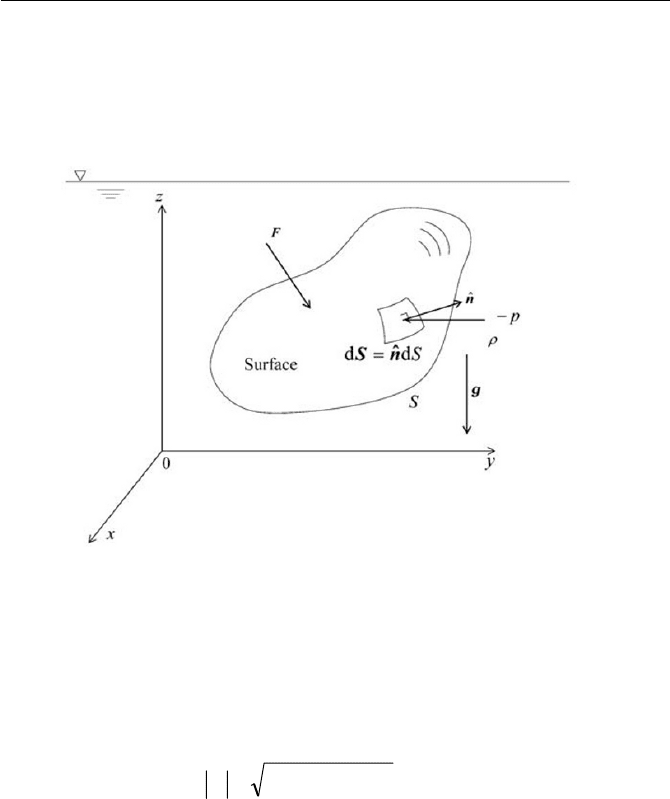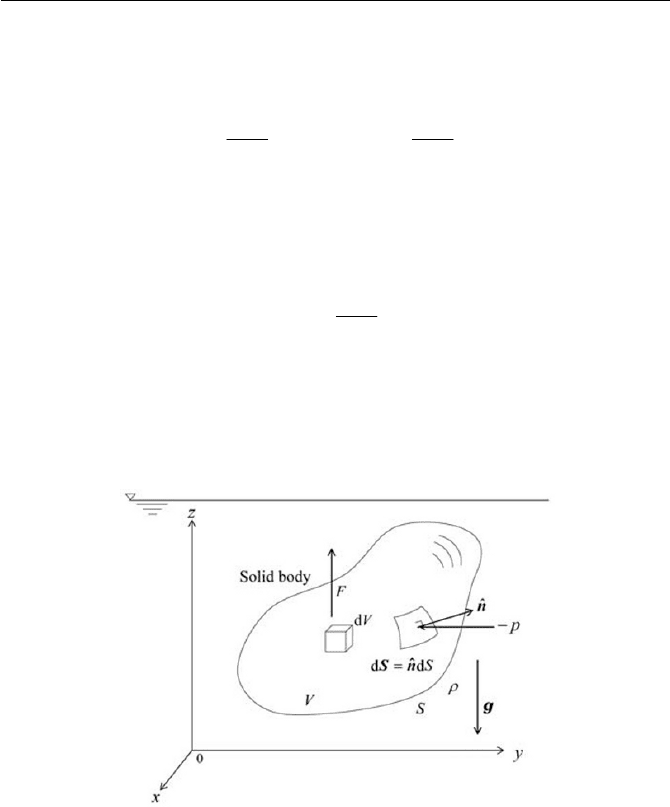Yamaguchi H. Engineering Fluid Mechanics (Fluid Mechanics and Its Applications)
Подождите немного. Документ загружается.


70 2 Conservation Equations in Continuum Mechanics
2-6. Obtain a form to calculate the power from Eq. (8) in Exercise 2.3.
Ans.
»
»
»
»
»
¼
º
«
«
«
«
«
¬
ª
2
2
1
2
2
1
1
22
axis.
aroundrotation flow theof
locity angular ve theiswhich in
Assume
ZZ
Z
ZZ
rrmNP
z
ruru
z
t
t
,,
2-7. In the energy conservation equation, Eq. (2.5.29), if the stress is sym-
metric, write a two-dimensional equation using the Cartesian coordi-
nates system (the
x
– y plane) assuming the thermal conductivity is
constant, and ignore the internal heat generation.
Ans.
»
»
»
»
»
»
»
»
¼
º
«
«
«
«
«
«
«
«
¬
ª
¸
¸
¹
·
¨
¨
©
§
w
w
¸
¸
¹
·
¨
¨
©
§
w
w
¸
¸
¹
·
¨
¨
©
§
w
w
¸
¸
¹
·
¨
¨
©
§
w
w
w
w
y
u
x
u
y
u
x
u
t
y
yy
y
yx
x
xy
x
xx
WWWW
u:IJ
useand0for
9-BAppendix See
Nomenclature
A
: pseudovector
321
A,A,A
: components of pseudovector
n
C
: diffusive transport of internal angular momentum
c
: couple stress tensor
p
c
: specific heat evaluated at constant pressure
v
c
: specific heat evaluated at constant volume
g
: body force
g
: gravitational acceleration
h
: specific enthalpy
k
: specific kinetic energy
c
k
: thermal conductivity
D
k
: thermal diffusivity
L
: external angular momentum
m
: mass
m
: mass flow rate
n
ˆ
: unit normal (surface direction) vector
p
: thermodynamic pressure

Bibliography 71
Q
: heat input
q
: heat flux vector
s
: specific entropy
Ad ,S
: surface element and surface areas
T
: total stress tensor
a
T
: skew-symmetric part of the tensor
s
T
: symmetric part of the tensor
T
: absolute temperature
t
: time
n
t
: stress vector
u
: velocity vector
u
: specific internal energy and
x
-directional velocity component
V
: finite volume of fluid particle or control volume
v
: specific volume (
U
1)
W
: work output
T
E
: coefficient of thermal expansion
U
: density
IJ
: deviatoric stress
Ȧ
: vorticity
Z
: angular velocity
Bibliography
Conservation laws in continuum mechanics are found in almost all texts. To a
detailed extent, angular momentum conservation and energy conservation are
found in the following texts listed below.
1. A. Rutherford, Vectors, Tensors, and the Basic Equation of Fluid Mechan-
ics, Prentice-Hall, Inc., Englewood Cliffs, NJ, 1962.
2. R. E. Rosensweig, Ferrohydrodynamics, Cambridge University Press,
Cambridge, MA, 1985. Republished from Dover Publications, Inc., 1997.
3. S. M. Richardson, Fluid Mechanics, Hemisphere Publishing Corporation,
New York, 1989.
3. Fluid Static and Interfaces
Now we will look at how the four general conservation laws we developed
in previous chapters can be applied to a great many important engineering
problems when we constitute the system of equations. For many physical
flows in engineering problems, the assumptions of frictionless or inviscid
and incompressible flows allow us to create a reasonably accurate model
representing practical situations.
For the sake of aiding understanding of how to apply the laws we have
just developed in closed systems, we will begin to consider a number of
simpler but still very useful models demonstrated in practical cases.
Fluid static is the simplest case in fluid engineering where the fluid is
at the static state in equilibrium, where the concept of pressure is of par-
ticular importance.
When fluids considered as continuum medium do not involve relative
motion between any parts of the fluid, the state of fluid motion is in static
equilibrium. Without the presence of velocity gradients in static equilib-
rium, the only stress present is the hydrostatic stress, except for in very
specific cases involving non-Newtonian fluids or electromagnetic medium.
The isotropic pressure, which acts normal to the surface of any orientation
of a fluid particle in static equilibrium, is the hydrostatic pressure, which is
identical to the thermodynamic pressure, as verified in Section 2.5.
Fluid static or hydrostatics deals with the mechanics of fluid in static
equilibrium. Fluids in static equilibrium may have common boundaries,
where two single phases are in contact. The pressure discontinuity across
the interface occurs due to surface tension, having the curvature of the in-
terface. This chapter also deals with a basic interfacial phenomenon, which
is often encountered in engineering applications.
3.1 Fluid Static
Let us consider linear momentum conservation with a fluid particle rotat-
ing in an inertial reference frame. From Cauchy's equation of motion,
73

74 3 Fluid Static and Interfaces
inertial reference frame, given in Eq. (1.2.12), we can write
gua
U
I
U
u Tේ)ේ2(
rr
(3.1.1)
Here
r
a is the relative acceleration and
r
u is the relative velocity to the
inertial reference frame. Since in static equilibrium there is no relative mo-
tion of fluid particles,
r
u can be set identically at zero. The total stress ten-
sor
T can be only written in term of the hydrostatic pressure
p
, which is
given in Eq. (1.6.11), and the body force
g
can be regarded as the force
due to gravity
g . Thus, Eq. (3.1.1) can be written as
g
U
I
U
p
r
a
(3.1.2)
Thus,
I
represents the centripetal acceleration and
I
is
2
22
r
I
,
In applications of hydrostatics, the body force is due to the gravity and
its direction is toward the center of Earth, where we can take the coordi-
nate
z for the positive direction opposite to the gravity as shown in Fig.
3.1. In an inertial reference frame, supposing there would not be rigid-
body rotational acceleration, i.e.
0
so that 0
I
and 0
r
a , Eq.
(3.1.2) can thus be written by the following ordinary differential equation
as
g
U
dz
dp
(3.1.3)
It is noted that
dp is positive when dz is negative, so that the pressure in-
creases when
z decreases, as depicted in Fig. 3.1.
With incompressible flows, we can assume the density
U
in Eq.
(3.1.3) to be constant. The variation of the pressure
p
in the z -direction
can be obtained by the integrating Eq. (3.1.3) with respect to
z as follows
zpp g
U
0
(3.1.4)
where
0
p is the reference pressure at 0 z . By converting pressure to
equate to the height of a liquid column, Eq. (3.1.4) can be written as
const.
0
gg
U
p
z
ȡ
p
(3.1.5)
given in Eq. (2.2.6), and the acceleration of the fluid particle relative to the
:
:
:
in which is the angular velocity and
r
is the radius of rotation. Equa-
tion (3.1.2) is the hydrostatic equation, which relates pressure distribution to
acceleration, body force and density.
:

3.1 Fluid Static 75
Fig. 3.1 Coordinate
z a
and pressure
p
The quantity g
U
0
p that appeared in Eq. (3.1.5) is referred to as the
piezometric head. Using columns of liquid, pressures are measured by ma-
nometers. Figure 3.2 shows a U-tube manometer, which may be used to
measure pressure
1
p
in a pipe or a vessel containing a fluid of density
1
U
.
The tube contains a liquid of greater density
2
U
than that of the metered
fluid. The datum line, from which the liquid columns levels of
1
z and
2
z
are measured, is located at
0 z as shown in Fig. 3.2.
a
p the atmospheric
pressure acts on the liquid column level of
2
z side, so that in static equi-
librium of the balance of pressure at the datum line can be written as
Fig. 3.2 U-tube manometer and inclined tube manometer

76 3 Fluid Static and Interfaces
22111
zpzp
a
gg
U
U
(3.1.6)
and solving for
1
p
a
pzzp
11221
gg
U
U
(3.1.7)
Thus, according to Eq. (3.1.7), the absolute pressure
1
p can be measured
by reading the scales of
1
z and
2
z . The read pressure (
1122
zz gg
U
U
) is
referred to as a gauge pressure. It is mentioned that at the vacuum,
1
p and
1
U
will be set zero, with which
2
z becomes a negative reading to the da-
tum line, metering
2
z as g
2
U
a
p . For the standard atmospheric pressure,
2
z is measured via a 760 mm liquid column of mercury; this implies that
mmbar]1013 [
a
p
5
100131 u . [
2
mN ]. For measuring gas pressure,
1
U
is much smaller than
2
U
, and Eq. (3.1.7) is simply written where
a
pzp
221
g
U
(3.1.8)
If the gauge pressure (
22
zg
U
) is too small to be read on the scale of
2
z ,
the liquid column can be inclined, as shown in Fig. 3.2 by the hatched lines.
This arrangement of a manometer is referred to as the inclined tube ma-
nometer, with which the reading of scale l on the tube is taken to give
T
sin
1
lz . The inclined tube enables the reading of the scale l to be re-
corded with greater sensitivity.
In engineering design of vessels, dams, water-gate and etc., there are
necessities for calculations of the overall magnitudes and representative
location of forces that act on a submerged plane or curved surface. In the
application of the hydrostatic equation in such engineering problem, we
shall consider forces on submerged surfaces. As shown in Fig. 3.3, force
F
acting on a surface, submerged in a liquid may be obtained by integrat-
ing the pressure
p
(the negative sign of
p
indicates the direction toward
the surface element, while the surface force acts toward the direction to a
unit normal vector
n
ˆ
is positive) over the surface as follows
³
S
pdSF
(3.1.9)
and
³
S
dSpnF
ˆ
(3.1.10)

3.1 Fluid Static 77
Next let us write the unit normal vector in terms of direction cosines as
ii
l eeeen
ˆˆ
cos
ˆ
cos
ˆ
cos
ˆ
321
J
E
D
(3.1.11)
After considering Eq. (3.1.11), thus Eq. (3.1.10) becomes
Fig. 3.3 Forces on submerged surface
332211
332211
321
eee
eeeeF
ˆˆˆ
ˆˆˆˆ
FFF
pdSpdSpdSdSpl
SSS
i
S
i
³³³³
(3.1.12)
and
2
3
2
2
2
1
FFF F
(3.1.13)
where
1
dS
,
2
dS
and
3
dS
are the projections of the elementary area Sd on 2–3
(
y – z ), 1–3 (
x
–
z
) and 1–2 (
x
– y ) plane, respectively. Equations. (3.1.12)
and (3.1.13) indicate that the overall magnitude of a force on a curved sur-
face is the vector sum of forces projected on each projection plane.
Consider a simple case, where a flat plate is submerged in a liquid to
the depth of
1
h and
2
h from the liquid level. Since the object is flat, we
can take the projection plane for the same direction of
n
ˆ
, and we can think
of that the plane as being placed with a constant angle
D
to the level of the
liquid, as depicted in Fig. 3.4. Hence, for convenience, a local coordinate
y

78 3 Fluid Static and Interfaces
along the plate surface is taken from a datum coordinate x at the liquid
level. The hydrostatic pressure
p
on the plate surface at the depth
h
from the liquid level will be easily calculated by Eq. (3.1.4) as
Fig. 3.4 Submerged plate
)( hp g
U
(3.1.14)
Here, only the gauge pressure is considered. Thus, the overall force acting
to the plate is
n
n
nF
ˆ
ˆ
ˆ
¸
¹
·
¨
©
§
³
³
³
A
A
A
hdA
dAh
dAh
g
g
g
U
U
U
(3.1.15)
The integral
dAh
A
³
can be calculated with the local coordinates
x
– y , re-
ferring to Fig. 3.4 as follows
AyydAdAyhdA
G
A
³³³
DDD
sinsinsin
2
1
2
1
(3.1.16)
Here,
G
y is referred to as the centroid,
³
2
1
x
x
dydA is the surface element
across the plate, and
A is the total surface area of the plate. Note that
G
x

3.1 Fluid Static 79
(
x
directional centroid) is rather irrelevant since
p
varies with respect to
h (and consequently to y ). Therefore, Eq. (3.1.15) becomes either
nF
ˆ
Ay
G
D
U
sing
(3.1.17)
or
nF
ˆ
Ah
G
g
U
(3.1.18)
From Eq. (3.1.18), it may be stated that the overall force exerted by a liq-
uid on a static equilibrium is the product of the surface area and the pres-
sure
G
p at the centroid,
GG
hp g
U
.
The representative point on the plate, where the overall force
F
acts
on the surface, is not at the centroid point, but is referred to as the center of
pressure
C
C x as shown in Fig. 3.4. The local coordinates
C
x (
C
x ,
C
y )
of the center of pressure
C are obtained by the concept that the moment
balance in the static equilibrium also been halted, as follows
³
u u
A
C
dAp )
ˆ
( nxFx
(3.1.19)
F
is given by Eq. (3.1.10). With reference to Fig. 3.4,
C
x with the local
coordinates (
C
x ,
C
y ) can be obtained from
C
x of Eq. (3.1.19) where
³
A
C
xdFFx and
³
A
C
ydFFy
(3.1.20)
Here,
F is F and dAyhdAdF
D
U
U
singg . Thus, with Eq. (3.1.17),
C
x and
C
y can be calculated to give
³
A
G
C
xydA
Ay
x
1
and
³
A
G
C
dAy
Ay
y
2
1
(3.1.21)
The integrations in Eq. (3.1.21),
xy
A
IxydA
³
and
x
A
IdAy
³
2
, are
called the product of the surface area
A and the second moment of the
surface area
A (or, alternatively, the product of inertia and the moment of
inertia of the surface area
A ) about
x
axis respectively. In addition, with
some algebra for the surface
A ,
xy
I and
x
I are expressed with respect to
the centroid axis parallel to the
x
and y axes in Fig. 3.4 as follows
GGxyxy
yAxII
c
and
2
Gxx
AyII
c
(3.1.22)

80 3 Fluid Static and Interfaces
where
xy
I
c
and
x
I
c
are those at the centroid axis. Thus, using the relation-
ship, Eq. (3.1.21) can be further written for
C
x
and
C
y
where
G
xy
GC
Ay
I
xx
c
and
G
x
GC
Ay
I
yy
c
(3.1.23)
In case, for a more simple geometric plate, such as when the plate area is
symmetric about any one of the centroid axis,
xy
I
c
becomes zero, so that
the center of pressure is expressed as
¸
¸
¹
·
¨
¨
©
§
c
G
x
GGC
Ay
I
yx ,x
(3.1.24)
This indicates that the overall force acting on the submerged plate is at a
deeper point
C
y than the position of the centroid
G
y of the plate. In appli-
cation of further geometric cases of plate, Table 3.1 lists some of represen-
tative
x
I
c
.
Fig. 3.5 Buoyant force on submerged body
With the same manner, in case of a curved surface, the overall force on
a surface can be obtained as the vector sum of each projected plate, as veri-
fied in Eq. (3.1.12), see Exercise 3.4.
With the extension of forces on submerged surface, we will now con-
sider the force acting on the surface of a solid body immersed in a fluid, as
shown schematically in Fig. 3.5. With the same manner as considered in
Eq. (3.1.9), we take a surface integral over the body where
